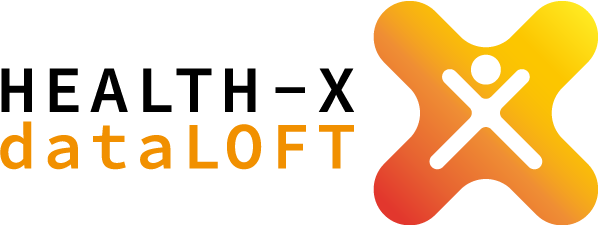Work Packages
WP1 – Establishing of Cloud Structures
Goal: Goal: Establish a Gaia-X compliant cloud infrastructure as the basis for linking ePA, clinical, and personal health data.
In WP1, we will develop the cloud for dataLOFT-compliant processing of data from personal smart health devices, define the necessary interfaces for Gaia-X interoperability of data offerings based on Gaia-X compliant standards, Gaia-X Federation Services, and IDSA connector technology, and develop and test operating models for this platform.
Deliverables/Outcome*: Technical design sketches of cloud infrastructures (M1, M4) Implementation plan for creating Gaia-X compliance and interoperability (M5).
WP1 is led by the collaborative partner IONOS SE.
WP2 – GAIA-X Technology Stack
Goal: Build the Gaia-X technology stack for data sovereign indexing and linking.
In WP2, concepts for the further development of Gaia-X-compliant implementation of IDSA technologies will be developed and implemented. In particular, compliance, implementation of secure computing technologies, ID management, data trustee, and Gaia-X-compliant self-descriptions of these services and properties will be addressed.
Results /*: ID management system & data trusteeship for identity and trust, IDSA technology implemented for DSS, SGX implemented in IDSA; Federated Catalogue self-description for Gaia-X Federation Services (M7).
WP2 is led by the collaborative partner Bundesdruckerei.
WP3 – Data space of the primary and secondary health sector.
Goal: Data space of the primary and secondary health sector by secureley connecting the infrastructures built in WP1 based on the technological concepts developed in WP2.
In WP3 we define the interactions and processes between the components of the health data space developed in AP3: consent management according to IDSA Metadata Broker, data discovery according to Gaia-X Federated Catalogue, implementation of the regulatory framework from UWP7.1, analysis of the interfaces of the data wallet app to the different data providers (WP3) and use cases (WP5), design and development of the data wallet app taking into account the end user view based on patient forums (UWP7.3), analysis of the expression of the corresponding standards of the Gaia-X Health domain, development of process control for use case class specific distributed processes to map data processing and communicating activities while maintaining personal data sovereignty between the involved actors.
Deliverables: appropriate Gaia-X connectors adapted (M10); semantic interoperable data space based on clinical standards FHIR, Snomed-CT, IHE, and clinical data flows and Gaia-X interfaces integrated into applications (M10).
WP3 is led by the collaborative partner SVA System Vertrieb Alexander GmbH.
WP4 – Citizen-Centric Data Access
Goal: Development of the data wallet app for citizen-centric data access and integration based on the Gaia-X compliant IDS technology stack and orchestration of application case specific distributed process.
In WP4, we are developing the data wallet app, the core component of the HEALTH-X dataLOFT health data platform, with which patients and citizens can act autonomously in the first and second healthcare markets. Through the data wallet app, they discover their data and make it available to the various providers in HEALTH-X dataLOFT for specific purposes and occasions. The data wallet app is the central control tool for the HEALTH-X dataLOFT platform.
Results Data wallet as a technical solution concept for process-based interactions and connections to the different data domains; extension of IDSA technologies to support use case class specific distributed processes (M11), data wallet app including notification stack for end users.
WP4 is lead by the collaborative partner Frauhofer ISST.
WP5 – Use Cases
Goal: Develop feasible and relevant use cases that demonstrate the potential of Gaia-X to improve healthcare and implement selected demonstrators.
The goal of work package 5 is to develop four feasible and relevant use cases that demonstrate the potential of Gaia-X to improve healthcare: Self-determined everyday health, clinical companion, personalized healthcare services, and secondary use of data. Selected demonstrators will also be implemented for the use cases. The development of the use cases will follow a user-centered process with the development of user journeys, collaboration with clinics and operators, and the involvement of end users in patient forums.
Results: Detailed description of 4 use cases (Self-Determined Everyday Health; Clinical Companion; Personalized Health Services; Secondary Use of Data) including societal added value, the benefits of Gaia-X in implementation and implementation plans (M8), evaluation and implementation of selected demonstrators (M14).
WP5 is led by the collaborative partner OFFIS.
WP6 – Business Models
Goal: Develop feasible and sustainable business models beyond the scope of the project based on technological developments from WP 1-4 and use cases in WP5.
In WP6, we define operator models and business models for the economic and social utilization of the developed technologies from WP1-WP3, for the data wallet app (WP4), and the use cases from WP5. In an agile process, we involve the stakeholder board, patient forums as well as members of relevant ecosystems - for example, startups via innovation forums - in the development and use of new concepts. We initiate agile real labs in which we iteratively test and concretize our concepts with a focus on citizen and patient associations.
Results: Initial conceptual design of operator models (M1, M2); interim planning status & testing of agile iterative exploitation planning (M9a-c); operator models, platform visions & exploitation scenarios of economic partners concretized (M12); selected demonstrators realized (M14).
WP6 is led by the collaborative partner FU Berlin.
WP7 – Cross-Work Package Activities
Goal: Consideration of ELSI, reference to end-user perspective and clear target architecture for the project.
In WP7 we create a definition of the target architecture of the dataLOFT platform considering ethical, legal, and societal aspects and implications (ELSI). Through stakeholder board and regular iterative work on the target architecture, we operate the requirements management for WP1-WP4.
Results: Definition of target architecture (M1); clarification and a better understanding of regulatory framework (M2 & M12), consideration of end-user perspective.
WP7 is led by the collaborative partner Charité - Universitätsmedizin Berlin.
AP8 – Project Management PMO
Goal: Coordination of consortium partners and work packages for timely implementation of the project.
In AP8 we coordinate the overall project. We organize regular coordination meetings, prepare reports, are responsible for financial reporting, track project progress, take care of internal, and external communication via website and social media, staff, and manage stakeholder board and patient forums.
Deliverables: Consortium meetings, external outreach; annual progress reports.
WP8 is led by the consortium partner Charité - Universitätsmedizin Berlin.
WP9 – Clearinghouse Interoperability
Goal: Ensure interoperability of the systems and interfaces developed in the various WPs.
In WP9, we are working with WP7 and WP8 to ensure, in the spirit of project success, that the technical solutions not only meet regulatory requirements and formally fulfill their requirements, but are also suitable in their entirety to represent the HEALTH-X dataLOFT platform by the interlocking interoperable technologies.
Results: Interoperability of interfaces, documentation of interfaces, and processes.
WP9 is led by the collaborative partner Charité - Universitätsmedizin Berlin.

Questions?
Of course, our website can only provide you a rough insight into the HEALTH-X dataLOFT. If you have any questions about the project, please feel free to contact us at info@health-x.org.
